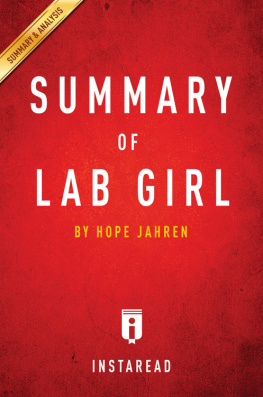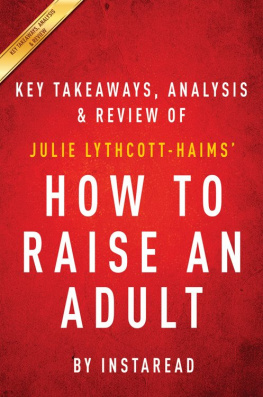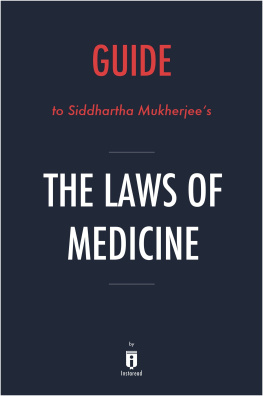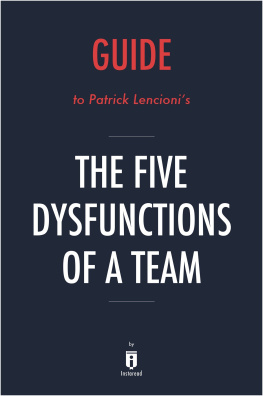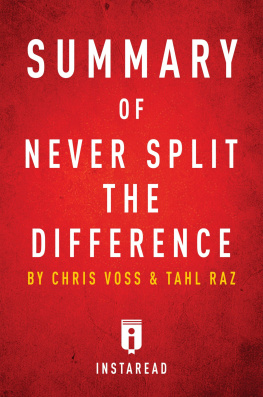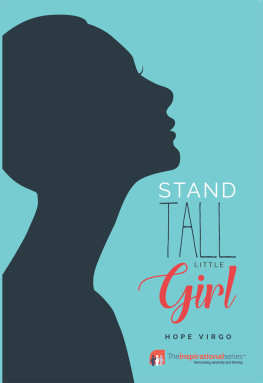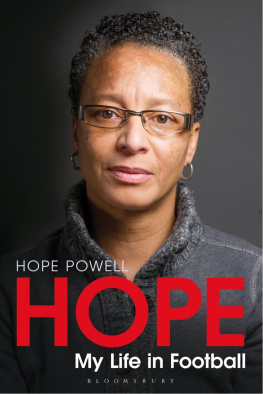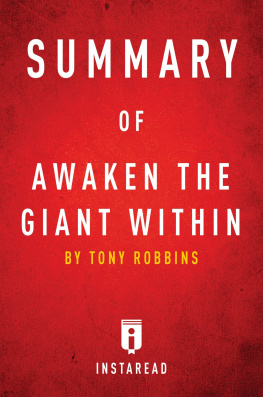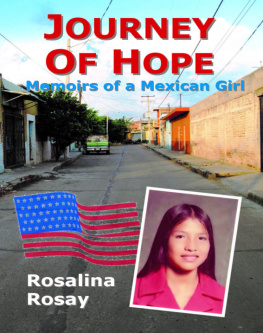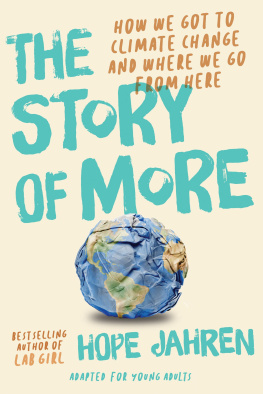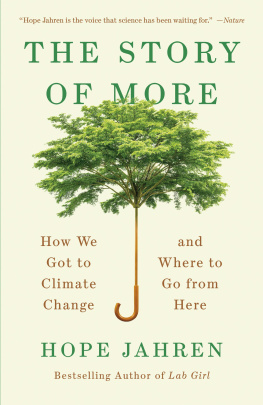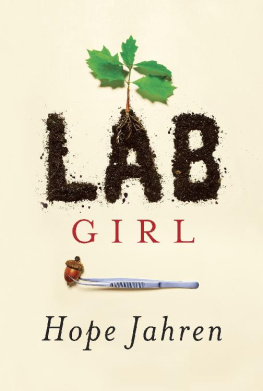Summary of
Lab Girl
by Hope Jahren

Instaread
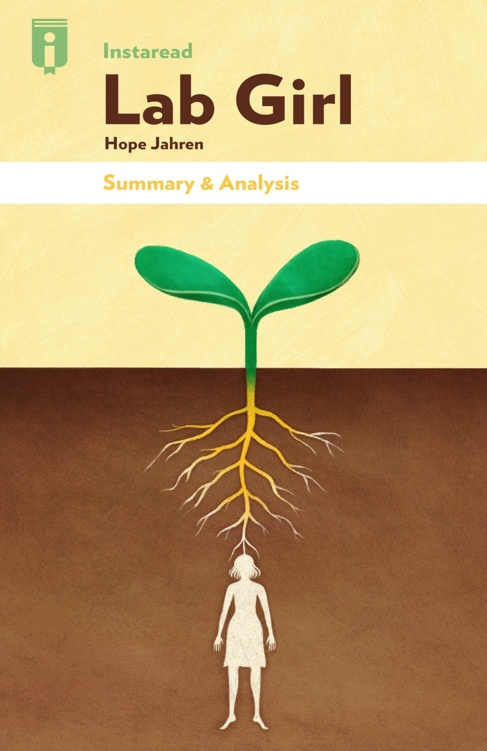
Please Note
This is a summary with analysis.
Copyright 2016 by Instaread. All rights reserved worldwide. No part of this publication may be reproduced or transmitted in any form without the prior written consent of the publisher.
Limit of Liability/Disclaimer of Warranty: The publisher and author make no representations or warranties with respect to the accuracy or completeness of these contents and disclaim all warranties such as warranties of fitness for a particular purpose. The author or publisher is not liable for any damages whatsoever. The fact that an individual or organization is referred to in this document as a citation or source of information does not imply that the author or publisher endorses the information that the individual or organization provided. This concise summary is unofficial and is not authorized, approved, licensed, or endorsed by the original books author or publisher.
Table of Contents
Summary
In her memoir Lab Girl, Hope Jahren describes the life shes lived and the knowledge shes learned as a scientist trying to find her way in the world. Focusing mostly on a period of professional development that stretches from 1997 to 2008, the bulk of the narrative follows Jahren from her first appointment as a professor in Atlanta to her current job at the University of Hawaii. Navigating personal and professional challenges including bipolar disorder, meager budgets, and sexist work environments, Jahren and her eccentric lab manager, Bill, learn a lot about themselves, each other, and the mysterious lives of plants.
Growing up in Minnesota, Hope feels starved for human connection. Her parents and her three older brothers are quiet, distant, and seemingly emotionless. The only sure love in her life is the feeling she experiences in her fathers laboratory, a place where she feels happy and curious. Hopes father is a physics teacher at a local community college. During her childhood, he lets her indulge her scientific impulses to her hearts content. Even at a young age, she seems to grasp her identity as a scientist. This certainty will serve her well later in life when her competence is continually called into question by sexist colleagues.
As an undergraduate at the University of Minnesota, Hope initially focuses on literature. Soon she moves to hard science. On top of her studies, she works to support herself. One memorable work experience involves her brief tenure at a hospital pharmacy where shes hired as a runner, a person who distributes custom-made medications throughout the facility. Eventually she earns a promotion and begins to produce the medications herself by mixing solutions for IV bags. This highly detailed work requires sterile conditions and special technique. Hope is mentored by Lydia, a long-time employee. Rough around the edges, Lydia is known for her gruff attitude and her chain smoking, but shes maternal in her own way. Though Hope finds the high-stakes work nerve-wracking at first, she soon masters it and grows bored and discontent. When shes offered a job working at a laboratory on campus, she gives her notice at the hospital. Hope is so self-important about the opportunity to better herself that she inadvertently offends Lydia.
Hope goes to the University of California, Berkeley to earn her doctorate. In 1994, while working as an assistant to a professor, she meets Bill, an undergraduate student in one of her classes. Over time, he will become the most important person in her life, but for now they bond over their aptitude for the work and their mutual disdain for everyone else. Recognizing his ability almost immediately, Hope helps him secure a job at the lab where she works. Its part-time, but he puts in long hours doing unpaid work. He does not yet know this arrangement will become a running theme in his association with Hope.
After zipping through her coursework and completing her dissertation in just four years, Hope graduates in 1996, the same year that Bill finishes his bachelors degree. Her plan is to go to Georgia Institute of Technology, where she secured a job offer the year before. Graduation is a grim affair for Hope and Bill, whose families dont attend. The night after the ceremony, they retreat to their lab. Hope indulges in a daydream about her future which results in a frightening accident involving exploding glass. Shes badly shaken, but Bill remains cool and competent. Impressed and grateful, on a whim, Hope asks him to follow her to Georgia Tech. He agrees. Hope moves to Atlanta to establish herself, with a plan in place for Bill to follow her after the first semester.
Bill arrives in Atlanta in early 1997. Hope, whos only 26, has had trouble adjusting to her role as assistant professor. She feels emotionally immature and ill-equipped to work with people who feel more like peers than students, and shes been suffering from what a doctor has diagnosed as anxiety. The one thing shes been looking forward to is setting up her lab, but her excitement dissipates when she shows the space to Bill. Suddenly, the facility looks rickety and inadequate. If Bill is disappointed, he doesnt let it show, and together they set up equipment and make repairs.
Although Hope and Bills relationship is one of friendship rather than romantic love, they grow closer during their tenure at Georgia Tech, which lasts for about three years. Their lives there are far from glamorous; they begin with little money and end with even less. Hope, who lives in an apartment nicknamed the Rat Hole, subsists on Ensure, a nutrition drink thats popular among sick and elderly people. On at least one occasion, she eats dog food.
When the funding for Hopes research dries up, shes unable to pay Bill, whose salary isnt guaranteed by the university. His living situation steadily deteriorates. First he lives in a bedbug-infested apartment, then a dilapidated van, and finally a student office in the building that houses the lab. Meanwhile, Hope feels like a professional failure. Her theories arent gaining traction, and she often feels disrespected by her colleagues. Her applications for grant money are routinely denied. As she worries about herself and Bill, whos literally homeless, her anxiety intensifies. Bill, whose belief in her ability never wavers, remains a steady source of professional and emotional support. Though they have some good times, it increasingly becomes clear that their situation at Georgia Tech is untenable.
During this time, and presumably for many years prior to her job at Georgia Tech, Hope privately tries to manage her bipolar disorder, which will remain undiagnosed for years. Her manic episodes lead to several professional misadventures, especially on road trips with students. One memorable anecdote involves a cross-country car trip that Hope makes with Bill and two students. Its a bad idea from start to finish; highlights of the journey include an ice storm, a car crash, and an unfortunate accident involving plastic two-liter bottles that the passengers urinate in during their long hours on the road. Something about Hopes relationship with Bill solidifies during this intense and jarring experience. Feeling deeply appreciative of his unwavering loyalty, she begins to think of him as more of a family member than a colleague.
About six months later, in the summer of 1999, Hope and Bill move to Baltimore to take jobs at Johns Hopkins University. Things begin to fall into place for Hope, professionally and personally. She inherits old lab equipment from one of her academic mentors. Her bipolar disorder is diagnosed and treated. Bills situation also improves, if less dramatically. He takes up residence in Hopes attic. The pair grow even closer during a summer work trip to the Alaskan wilderness. Their friendship deepens as they dig for rare wood fossils and discuss some of the social challenges that Bill has faced over the years. As a child, Bill lost part of one hand. This physical abnormality and his naturally eccentric ways were often mocked by other kids. Now well into adulthood, hes never dated, and he doesnt seem to have any friends aside from Hope.
Next page
